

|
Soundclip:
|
| See Steve's Hand-Written Solo
Transcription |
|
Steve Khan's solo on: "Concepticus in C"(Greg Osby) When "SUBTEXT" was recorded in 2014, "Heard" written by saxophonist Greg Osby was one of my favorite tunes on that album. It is therefore not surprising that his "Concepticus in C" became one of my absolute favorites on "BACKLOG"! The original version appears on Greg's album, "ZERO"(Blue Note) which was recorded in 1998, but it was only during late 2016 that Greg told me that the "C" part of this "concepticus" had nothing to do with key of 'C' - which would have made no musical sense at all - at least to me - but, it was dedicated to his years working alongside fellow saxophonist, Steve Coleman. 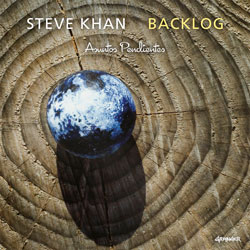 When we recorded "Heard," I remember presenting my demo to Rob Mounsey who just couldn't stop smiling at that piece of music, and the more he got into it while playing the keyboard part that I had written he seemed to be responding to the tune. At a certain point in our work together on it, Rob said to me something like this: "You know what? This piece is completely counterintuitive!" Of course, with Rob's great intellect, this made me smile and laugh, a lot. As you can see, I still think about that comment to this day. When I hear these tunes of Greg's I also recall, all the times that Will Lee and I might have been together playing strange Fusion tunes in the '70s, even at times tunes by Randy Brecker, and Will might say to those assembled in a voice made to resemble a first time visitor to this planet from Mars: "This is the music of my people!" Well, if this was, in fact, the music of my people, I would be proud to stand-up and shout from the rooftops that very same phrase! I just love these tunes by Greg Osby! When we recorded "Heard," I remember presenting my demo to Rob Mounsey who just couldn't stop smiling at that piece of music, and the more he got into it while playing the keyboard part that I had written he seemed to be responding to the tune. At a certain point in our work together on it, Rob said to me something like this: "You know what? This piece is completely counterintuitive!" Of course, with Rob's great intellect, this made me smile and laugh, a lot. As you can see, I still think about that comment to this day. When I hear these tunes of Greg's I also recall, all the times that Will Lee and I might have been together playing strange Fusion tunes in the '70s, even at times tunes by Randy Brecker, and Will might say to those assembled in a voice made to resemble a first time visitor to this planet from Mars: "This is the music of my people!" Well, if this was, in fact, the music of my people, I would be proud to stand-up and shout from the rooftops that very same phrase! I just love these tunes by Greg Osby!It was during a 2003 European tour with Terri Lyne Carrington, Greg Osby, and Jimmy Haslip, that I had the privilege of playing some of Greg's music, and "Concepticus in C" marks the 2nd of those tunes to be recorded that we performed live. Just as I did with "Heard," "Concepticus" is played here as Cha-cha-cha, and anchored by Rob Mounsey's spectacular interpretation of my keyboard arrangement that I wrote for the piece. As I attempted to do with "Heard," I took Greg's brilliant melodic lines and harmonized them as I saw fit. If one knows Greg's recorded version from his own CD, "ZERO," you can hear the difference. His original [B] section really had no specific written melody, so I listened to our live performance, and grafted fragments of what Greg had played onto my arrangement. 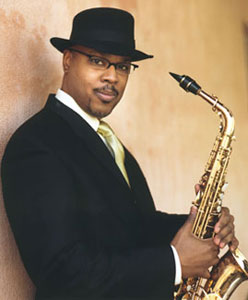 But just as it was before, I had to also invent a solo format and that was tricky! As this concepticus is really centered, at least as I hear it, around 'D' - the first three solo sections reflect that in different ways and each one is derived from a sonority that actually appears during the statement of the [A] melody sections. As we analyze the solo, I will try to point out to you where each of these sonorities appears in the keyboard part. And, speaking of these melody sections, I would tell you that I could listen to how Marc Quiñones chose to interpret them 1,000 times, and never get tired of it. It is, yet again, a great example of Marc's most unique musicianship skills. But just as it was before, I had to also invent a solo format and that was tricky! As this concepticus is really centered, at least as I hear it, around 'D' - the first three solo sections reflect that in different ways and each one is derived from a sonority that actually appears during the statement of the [A] melody sections. As we analyze the solo, I will try to point out to you where each of these sonorities appears in the keyboard part. And, speaking of these melody sections, I would tell you that I could listen to how Marc Quiñones chose to interpret them 1,000 times, and never get tired of it. It is, yet again, a great example of Marc's most unique musicianship skills.The solo begins immediately following a 2-bar break figure which appears throughout the piece. One thing that, for me, is an important element in my playing is that I always want to maintain some connection to the blues language and even how that special genre relates to the guitar. No matter how sophisticated or "out there" a piece of music might be, I always try to find a sense of the blues within it. "Concepticus" is no different. At no point within this solo framework do we have a straight dominant 7th chord, nor a straight minor 7th chord. Each sonority involves its own series of tensions and complex harmony that, as you will see, at times can be existing in some netherworld - neither here, nor there. What informs this solo, and should be a part of any improvisation is that, melodic material from the tune itself is one of the first building blocks. Though Greg's melody is extremely active from a rhythmic perspective, the character of the notes has always stayed with me. And you find notes like Eb, F#, C, F-natural, Ab all mixed together, giving one's ears that sense of D7 with alterations. The first section, letter [C], is 16 bars in length, and it was built around a D7(alt.) sonority that appears in some form in bar 1 of the letter [A] melody. The alternations that one hears with sharp rhythmic punctuations are, at varying times, the #9, b9, and b5. Generally speaking, over such a chordal area, you would expect to hear lines derived from the D altered dominant scale [D, Eb, F, F#, Ab, Bb, C], and over the course of these 16 bars, most of the notes do conform. For example, the bent notes: C in bar 1; D in bar 4; and Eb in bar 8. The first lines in bars 2-3, accentuate the b5(Ab) and the #9(F) with the line concluding on the b9(Eb). For me, hearing line configurations like this remind me of all the years spent standing next to both Randy and Michael Brecker, and listening to their linear explorations which expanded my vocabulary and showed me just what was possible by toying with the slightest movement of a critical note or two. In bars 5-6, you will hear me using a B-natural, which is not part of that previously mentioned altered dominant scale, but it is a part of the blues language as I know it. It is quite traditional to play the 6th degree to the root, just as you might play the 5th to the root. Both can be most expressive. So, you will again hear that same B-natural used in the line in bar 7 as well. Bar 9 begins by, in part, spelling out an Ab triad over these D7(alt.) sounds, with the line tailing off on the #9, a blue note. In bars 10-11, you have the only real appearance of the usage of the actual altered dominant scale as it descends from a high F-natural all the way down to a C-natural about an octave and-a-half below. The only scale tone that is skipped is Ab(b5). The phrase that answers in bars 11-12 is again a part of the Brecker Bros. linear language, and toys with the relationship of 3rd and the minor 3rd(#9). 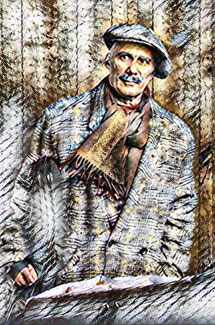 It is about how you employ those notes and the notes that precede them more that make too much of where they appear. In the end, it is about a natural sense of subtlety. This idea continues in bar 13 but with rhythmic variety as triplets are used. In bars 14-15, the bluesy sense of using the root comes into play as it is accentuated by being anticipated by both the b7(C) and 6th(B) degrees. If to one's ears that 6th degree, the B-natural, sounds good, even if it is nowhere to be found in any of the chordal sounds, then you are feeling the blues elements as you should be. The section concludes with a sequence of ascending major triads: F-Ab-B in alternating sequence up to a high D-natural. It is about how you employ those notes and the notes that precede them more that make too much of where they appear. In the end, it is about a natural sense of subtlety. This idea continues in bar 13 but with rhythmic variety as triplets are used. In bars 14-15, the bluesy sense of using the root comes into play as it is accentuated by being anticipated by both the b7(C) and 6th(B) degrees. If to one's ears that 6th degree, the B-natural, sounds good, even if it is nowhere to be found in any of the chordal sounds, then you are feeling the blues elements as you should be. The section concludes with a sequence of ascending major triads: F-Ab-B in alternating sequence up to a high D-natural.[C2] also begins with a bent note, this time an Eb, that is also played forcefully on beat 2. I have to admit that the chordal sonorities in this 8 bar section ended-up being completely baffling to me. They were derived from what the keyboard briefly played in bar 2 of the [A] melody section. What makes it so odd is that you have an Eb7(sus) sound played on the 1st beat of each bar, but that sound darts away as a Dm7(sus) quickly appears. You can hear the top voice moving up from Eb to F as the chord changes, and bottom voice moves down from Ab to G. I remember sitting down many times while preparing and practicing for the recording and playing along with my own demo and this 8-bar section arriving and being so frustrated by feeling that none of the options that I thought might sound good were working. But, I was not going to let that deter me. In the end, as bizarre as this might seem, or might even sound, my ears took me more to a sense of Eb7 or Eb blues than anything to do with Dm7. However, for yourself, you would have to decide what sounds good to you. That is the only thing that is going to matter! It is for this very reason that, on the pages for the keyboard parts (you'll find that link below), I have given you a soundclip for the solo section from the original demo. You can use it, and play along without any distractions from me. It is the only way that you can hear what I was facing, and then feel free to experiment and make your own musical choices. In bar 2 of the section, it is interesting to note that here I heard more of a sense of D7(alt.) rather than either Eb7 or Dm7. Notice the the line contains both Bb(A#), the #5, and Eb, the b9. Of course, both of those tones are part of our Eb7(sus) sonority, so the line touches upon both worlds. In bars 3-4, this line is also part of the chromatic blues language in Eb and it concludes with an emphatic statement of G-natural to Bb, the 3rd to the 5th of Eb7. Remember that all of this is going on and there is still a clear sense of D as the tonal center, in the 2nd half of each bar. Listen to what Rubén Rodríguez' baby bass is playing, that is so important to it all. In bar 5, there is again a clear sense of leaning on the Eb7 blues sounds as I played Bb to Db with a heavy emphasis on that Db. And that note is carrying over while D7 or Dm7 of some sort is sounding. How can that sound good? Again, you have to be the judge. The line in bars 6-7 is a very traditional blues-type line and, just as you saw/heard over the D7(alt.) chordal sounds, here the 6th degree(C) of Eb7 is put to use. This line concludes on a Gb, again the blue note, which is just slightly pulled at to place it as a microtone - neither Gb or G-natural. The transition to the next section is made by anticipating the coming chordal sounds while gluing it all together with the simplicity of the blues. As [C3] arrives, the bass becomes even more entrenched around the center of D-natural, but even as the harmony has changed, the feeling of the piece stays consistent. The harmonic germ for the changes of this section come from sonorities that are touched upon in bar 5-6 of the melody. Again, if you look into the keyboard part, you can see that these same voicings dart by. Again, you have a D-pedal, and because there is also the b7(C-natural) in the bass line, there is a 7th chord feeling to it, but, because you have an Eb triad on the 1st beat, this gives a bit of a Spanish or Flamenco-esque mood to these 8 bars. Yet, that sound does not resolve down to a clear D major or D minor. It lands on a very open and ambiguous sound of: A-D-E-A. There's no 3rd present, but, to my ears, there was a sense that there could be an F# there. However, what I played revealed a completely different option. If you look at the notes from the pick-up to the section into bars 1-3, there is more of a feeling of A-blues than anything else. Even the bent not D-natural, feels like a note from the A blues scale [A, C, (C#), D, Eb, E, G]. 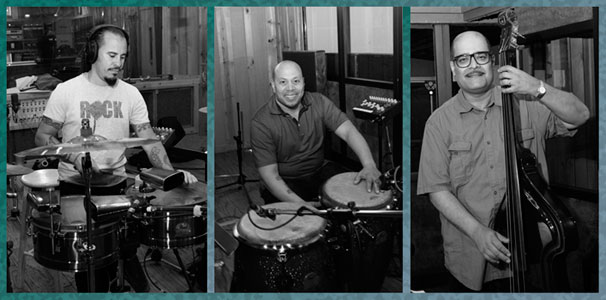 The bebop oriented line in bar 4 feels more like G Dorian [G, A, Bb, C, D, E, F] to me with the G's and Bb's keeping things close to that Eb triad. Finally, in bars 6-7, you see a line that not only reveals that mournful Spanish sound Eb/D, but you finally have the appearance of an F# to give us that sense of D major for a moment. In bar 8, as the line makes the transition to the next chordal sonority, you see a focus on the D major triad. The bebop oriented line in bar 4 feels more like G Dorian [G, A, Bb, C, D, E, F] to me with the G's and Bb's keeping things close to that Eb triad. Finally, in bars 6-7, you see a line that not only reveals that mournful Spanish sound Eb/D, but you finally have the appearance of an F# to give us that sense of D major for a moment. In bar 8, as the line makes the transition to the next chordal sonority, you see a focus on the D major triad.When I constructed the solo format, I knew that there was going to have to be another chord change that would not continue to use the D-pedal, and so, at [C4], I used a chordal sound that does not appear anywhere in Greg's tune. I wanted a chord that would pick-up the intensity, harmonically speaking, and so the bass line moved down a minor 3rd to B-natural, and the chord became B7(13b9). To add to that, you hear on the downbeat of all the even-numbered bars of the section a sound that also adds in the #5(G-natural) and the #9(D-natural). Against this tension, bars 1-5 turn to the blues yet again with a heavy emphasis on the root and the 5th(F#). In bar 3, in keeping with the altered sense of this chord, I touched about a C-natural(b9) as an upper neighbor to our root. In bar 6-7, the double-time line is more closely related to the B altered dominant scale [B, C, D, D#, F, G, A], but with a touch of the B blues scale as well [B, D, (D#), E, F, F#, A]. In the bluesy ending to the line, notice on the C-natural is slipped in there as a colorful chromatic upper neighbor. In bar 8, the transition line, which uses fragments of the B 1/2-tone/whole tone diminished scale [B, C, D, D#, F, F#, G#, A] to vault towards a resolution on the next chord and the area of A Phrygian. The sequence of this last line, for me, is really something that I associate with Chick Corea's piano style, but he usually does something like this: D-Eb-F#-A, F-F#-A-C, G#-A-C-Eb, etc. In the diminished cycle of minor 3rds, B, D, F, and Ab are all related as patterns can just repeat themselves, so in resolving to Gm9/A, the last 4 notes: F-Eb-D-C could easily be associated with the D altered dominant scale [D, Eb, F, F#, Ab, Bb, C]. Finally we arrive at letter [D] which is a direct refection of what appears in Greg's tune at letter [B]. The first 4 bars are an area of Gm9/A which I think of as A Phrygian [A, Bb, C, D, E, F, G], but for me, as I keep everything, as much as possible, in Dorian minor, I am relating to it as G Dorian [G, A, Bb, C, D, E, F]. Notice that the notes are exactly the same. Between bars 1-2, there is touch of bebop once again with a return to the blues with an emphasis on the notes A and C which are certain a part of the A blues scale which I had outlined earlier. The line in bar 4 of the section is really derived from using the C dominant 7th pentatonic [C, D, E, G, Bb], which I always associate with McCoy Tyner, as we descend to land on a Bb, which is part of the chord we have been on and the new chord as well. As the harmonic movement is the same as in the composition itself, we move everything down a whole-step, and so we now have a G Phrygian [G, Ab, Bb, C, D, Eb, F] area, and Fm9/G. But just as it was for the prior chord, I think of this as F Dorian [F, G, Ab, Bb, C, D, Eb]. At the risk of repeating myself, compare the notes in each mode, they are exactly the same. In bar 6, you see an ascending line that begins with an F minor triad and clearly use notes directly from F Dorian. Along with Rob Mounsey's beautiful Rhodes colors, this is going to sound like you are playing in G Phrygian. In bar 8, the section ends with another nod to the blues language, this time it is with the F blues scale [F, Ab, (A), Bb, B, C, Eb], except that I am again using the 6th(D-natural) instead of the 5th in the line configuration. To me, this is still very much a part of the specific blues language that all guitarists who have immersed themselves in the tradition might call upon and use liberally. The last section of the solo is really an additional 4-bar [Tag] to transition out of the solo and guide us back to our [I] Intro and eventually a restatement of Greg's main melodies. For these bars we finally arrive at a really V7 chord to the D7 area we have inhabited for most of the tune. If you look at the keyboard sonorities, I am using a favorite sound of mine where you stack to triads on top of one another, in this case, an A triad(C#-E-A) on top of a G triad(D-G-B) over A in the bass, to a G triad(D-G-B) on top of an F triad(F-A-C) over G in the bass. The end result of these sounds is that it still feels as though you are in an A7 oriented area. Notice that the line in bars 1-2 are right out of the A blues scale. Finally, there is an ensemble figure in bars 3-4, which I played in octaves, and another superb Marc Quiñones avanico leads back to [I]. Though I believe that it is easily understandable, there can be no doubt that the insistent and forceful rhythms of the Cha-cha-cha are the most easy for non-Latinos to get into. And for me, how lucky can one guy be than to have this sabor Nuyorquino laid down by three of its greatest proponents: Marc Quiñones(timbal & güiro), the big tumbao of Bobby Allende(conga), and Rubén Rodríguez(baby bass). Helping to put it all together with the sophistication of Jazz and Fusion is the spectacular Mark Walker(drums). Their performances are simply brilliant and so very creative the whole way through. I could listen to Marc and Mark negotiate the complex melodic rhythms of the [A] sections 1,000 times, and I never get tired of hearing their inventive interpretations as each go 'round came about. I can't stop grinning from ear to ear listening to them play. Perhaps the very last touch that added to this arrangement was when we were discussing the final two bars, Marc Quiñones suggested to Bobby, Rubén, and Mark Walker that we into an ever so brief hint of the Mozambique rhythm. It reminded, yet again, that without these kinds of touches, the end result of all this work would seem rather ordinary. But, this is why I put my great trust and faith in Marc to make these kinds of suggestions and decisions. There is no way that I have the kind experience to come-up with such things. I'm so grateful for little moments like this! My friendship and musical association with the great Rob Mounsey now spans some 40 years. It is hard to believe, sitting on this end of the time spectrum, that it has actually been that long. We have contributed to each other's projects, and made two wonderful recordings together as well: "LOCAL COLOR"(1987) and "YOU ARE HERE"(1998). I treasure both of them. Rob's contributions to my recordings, beginning in 2005 with "THE GREEN FIELD" have been immense. In the end, I could not have done any of them without his help, guidance, voice of sanity & supreme musicality. On "BACKLOG," the increased importance of Rob's keyboard role became a huge part of this album. His work on "Concepticus in C" was absolutely crucial to the overall sound and feeling of the piece. 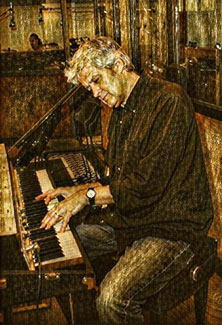 Now having posted the KEYBOARD LEAD SHEETS for "Our Town," "Invisible" and "Emily" at KHAN'S KORNER 1, it becomes a necessity to present them here as well. Again, I thought that, for those of you who might be interested in such things, you can actually see what I wrote out for Rob, and then hear exactly how fantastically he performed all those parts. For me, working closely with a musician of Rob's talent level, it is important to not be wasting his time with my own uncertainty about what I might need from him on the keyboard. So I spend a great deal of time working things out at home before I present him with anything. Then, once he has the parts, and we've discussed them, should questions arise, he can contact me, and we can work out whatever the problem might be. It can be as small as a badly written accidental, or something more complex. In the end, I value Rob's opinion so much that I'm grateful for anything that he has to say. Fortunately for me, where "Concepticus" was concerned, very little changed from what I presented him with. For those of you who choose to investigate these lead sheets, I hope that you will discover something more about Rob's artistry, and great musicianship. Now having posted the KEYBOARD LEAD SHEETS for "Our Town," "Invisible" and "Emily" at KHAN'S KORNER 1, it becomes a necessity to present them here as well. Again, I thought that, for those of you who might be interested in such things, you can actually see what I wrote out for Rob, and then hear exactly how fantastically he performed all those parts. For me, working closely with a musician of Rob's talent level, it is important to not be wasting his time with my own uncertainty about what I might need from him on the keyboard. So I spend a great deal of time working things out at home before I present him with anything. Then, once he has the parts, and we've discussed them, should questions arise, he can contact me, and we can work out whatever the problem might be. It can be as small as a badly written accidental, or something more complex. In the end, I value Rob's opinion so much that I'm grateful for anything that he has to say. Fortunately for me, where "Concepticus" was concerned, very little changed from what I presented him with. For those of you who choose to investigate these lead sheets, I hope that you will discover something more about Rob's artistry, and great musicianship.And so, with the solo on "Concepticus in C," the presentation of music from "BACKLOG" has arrived at its conclusion. It has been very special for me to share this music with everyone who visits the site with regularity. To read all of your e-mails and Guestbook entries has been most rewarding for me, and for all the players involved. After all, the music is for you. So, as we have hit December of 2017, we can only look forward to the new year, 2018, and hope for the best for our country, and, needless to say, for our world. Hopefully some people, those in power, will wake-up, and start to have a more broad view of what needs to be done to make life better for everyone, and certainly extend the lifespan of our glorious planet. Peace and love to you all!!! As we prepare to say "Goodbye!" to 2017, we are hoping that everyone has a very MERRY CHRISTMAS and a ¡FELIZ NAVIDAD! And, of course, now it is time to finally say, yet again, HAPPY NEW YEAR!!! Y por supuesto, les deseamos un muy ¡FELIZ AÑO NUEVO! Wishing you all good health, happiness, and again, please, PEACE everywhere!!! Thanks again for your wonderful messages via the CONTACT STEVE page, as well as the supportive comments that appear in our GUESTBOOK.
[Photos: Greg Osby
Steve Khan Photo by Richard Laird Collage: Marc Quiñones - Bobby Allende - Rubén Rodríguez Photos by: Richard Laird Rob Mounsey Photo by: Richard Laird] |